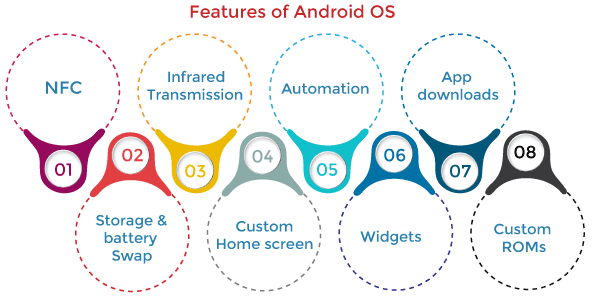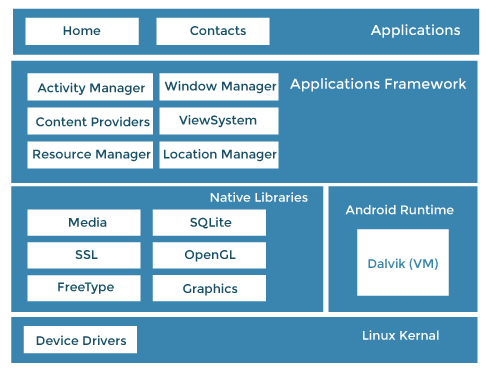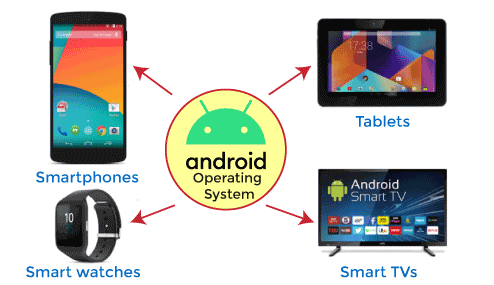Android Operating SystemAndroid is a mobile operating system based on a modified version of the Linux kernel and other open-source software, designed primarily for touchscreen mobile devices such as smartphones and tablets. Android is developed by a partnership of developers known as the Open Handset Alliance and commercially sponsored by Google. It was disclosed in November 2007, with the first commercial Android device, the HTC Dream, launched in September 2008. It is free and open-source software. Its source code is Android Open Source Project (AOSP), primarily licensed under the Apache License. However, most Android devices dispatch with additional proprietary software pre-installed, mainly Google Mobile Services (GMS), including core apps such as Google Chrome, the digital distribution platform Google Play and the associated Google Play Services development platform.
Features of Android Operating SystemBelow are the following unique features and characteristics of the android operating system, such as: 
1. Near Field Communication (NFC) Most Android devices support NFC, which allows electronic devices to interact across short distances easily. The main goal here is to create a payment option that is simpler than carrying cash or credit cards, and while the market hasn't exploded as many experts had predicted, there may be an alternative in the works, in the form of Bluetooth Low Energy (BLE). 2. Infrared Transmission The Android operating system supports a built-in infrared transmitter that allows you to use your phone or tablet as a remote control. 3. Automation The Tasker app allows control of app permissions and also automates them. 4. Wireless App Downloads You can download apps on your PC by using the Android Market or third-party options like AppBrain. Then it automatically syncs them to your Droid, and no plugging is required. 5. Storage and Battery Swap Android phones also have unique hardware capabilities. Google's OS makes it possible to upgrade, replace, and remove your battery that no longer holds a charge. In addition, Android phones come with SD card slots for expandable storage. 6. Custom Home Screens While it's possible to hack certain phones to customize the home screen, Android comes with this capability from the get-go. Download a third-party launcher like Apex, Nova, and you can add gestures, new shortcuts, or even performance enhancements for older-model devices. 7. Widgets Apps are versatile, but sometimes you want information at a glance instead of having to open an app and wait for it to load. Android widgets let you display just about any feature you choose on the home screen, including weather apps, music widgets, or productivity tools that helpfully remind you of upcoming meetings or approaching deadlines. 8. Custom ROMs Because the Android operating system is open-source, developers can twist the current OS and build their versions, which users can download and install in place of the stock OS. Some are filled with features, while others change the look and feel of a device. Chances are, if there's a feature you want, someone has already built a custom ROM for it. Architecture of Android OSThe android architecture contains a different number of components to support any android device needs. Android software contains an open-source Linux Kernel with many C/C++ libraries exposed through application framework services. Among all the components, Linux Kernel provides the main operating system functions to Smartphone and Dalvik Virtual Machine (DVM) to provide a platform for running an android application. An android operating system is a stack of software components roughly divided into five sections and four main layers, as shown in the below architecture diagram.

1. Applications An application is the top layer of the android architecture. The pre-installed applications like camera, gallery, home, contacts, etc., and third-party applications downloaded from the play store like games, chat applications, etc., will be installed on this layer. It runs within the Android run time with the help of the classes and services provided by the application framework. 2. Application framework Application Framework provides several important classes used to create an Android application. It provides a generic abstraction for hardware access and helps in managing the user interface with application resources. Generally, it provides the services with the help of which we can create a particular class and make that class helpful for the Applications creation. It includes different types of services, such as activity manager, notification manager, view system, package manager etc., which are helpful for the development of our application according to the prerequisite. The Application Framework layer provides many higher-level services to applications in the form of Java classes. Application developers are allowed to make use of these services in their applications. The Android framework includes the following key services:
3. Application runtime Android Runtime environment contains components like core libraries and the Dalvik virtual machine (DVM). It provides the base for the application framework and powers our application with the help of the core libraries. Like Java Virtual Machine (JVM), Dalvik Virtual Machine (DVM) is a register-based virtual machine designed and optimized for Android to ensure that a device can run multiple instances efficiently. It depends on the layer Linux kernel for threading and low-level memory management. The core libraries enable us to implement android applications using the standard JAVA or Kotlin programming languages. 4. Platform libraries The Platform Libraries include various C/C++ core libraries and Java-based libraries such as Media, Graphics, Surface Manager, OpenGL, etc., to support Android development.
5. Linux Kernel Linux Kernel is the heart of the android architecture. It manages all the available drivers such as display, camera, Bluetooth, audio, memory, etc., required during the runtime. The Linux Kernel will provide an abstraction layer between the device hardware and the other android architecture components. It is responsible for the management of memory, power, devices etc. The features of the Linux kernel are:
Android ApplicationsAndroid applications are usually developed in the Java language using the Android Software Development Kit. Once developed, Android applications can be packaged easily and sold out either through a store such as Google Play, SlideME, Opera Mobile Store, Mobango, F-droid or the Amazon Appstore. Android powers hundreds of millions of mobile devices in more than 190 countries around the world. It's the largest installed base of any mobile platform and growing fast. Every day more than 1 million new Android devices are activated worldwide. 
Android EmulatorThe Emulator is a new application in the Android operating system. The Emulator is a new prototype used to develop and test android applications without using any physical device. The android emulator has all of the hardware and software features like mobile devices except phone calls. It provides a variety of navigation and control keys. It also provides a screen to display your application. The emulators utilize the android virtual device configurations. Once your application is running on it, it can use services of the android platform to help other applications, access the network, play audio, video, store, and retrieve the data. Advantages of Android Operating SystemWe considered every one of the elements on which Android is better as thought about than different platforms. Below are some important advantages of Android OS, such as:
Disadvantages of Android Operating SystemWe know that the Android operating system has a considerable measure of interest for users nowadays. But at the same time, it most likely has a few weaknesses. Below are the following disadvantages of the android operating system, such as:
Next TopicBuffering in Operating System
|
 For Videos Join Our Youtube Channel: Join Now
For Videos Join Our Youtube Channel: Join Now
Feedback
- Send your Feedback to [email protected]
Help Others, Please Share










